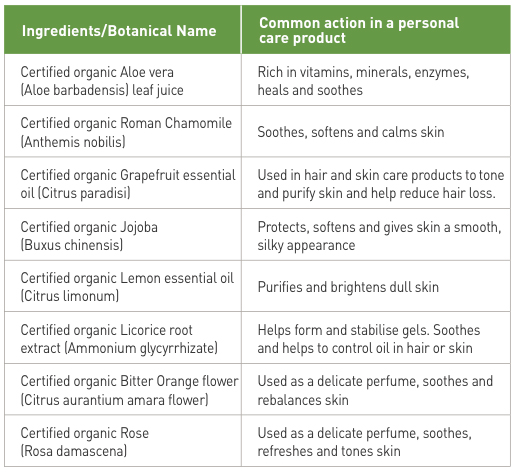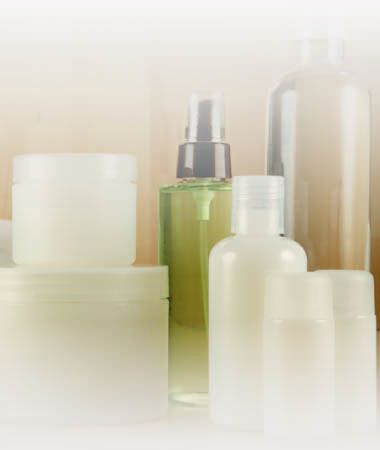"Natural," "all-natural", "green" and "pure" are marketing claims often seen on personal care products to entice consumers into purchasing products they perceive as derived from nature – the inference being that these products are therefore "better for you". As it stands, there are no regulations around the word "natural". Labelling a product "natural" often implies the absence of artificial flavours and no added colour or synthetic substances, however, these natural items may contain parabens, genetically modified organisms (GMOs) or chemical formulations. In addition, when brands place the word "natural" on a product label research has proven that it often causes confusion among some consumers who mistakenly believe that the product is just as good or the same as an organic product.
Whilst product education is more easily accessible today thanks to the internet and informative ingredient Apps, many consumers are still unsure or overwhelmed by conflicting marketing spins on packaging and the meaning behind certifications. We took a closer look at personal care certification in an effort to remove some of the mystery.
Certified organic
Certified organic is a trusted label given to products that undertake rigorous certification checks and strict monitoring. The three major certifying bodies worldwide are; COSMetic Australian Certified Organic (COSMOS-standard) in Europe, National Organic Program USDA (NOP) in the United States and Australian Certified Organic (ACO), Australia's largest certifier of organic and bio-dynamic products. Certification ensures compliance with national production standards and allows traceability of all products to their origin.
The COSMOS-standard is a result of a harmonisation effort in 2010 conducted by five leading European certification bodies: BDHI, Cosmebio, ECOCERT, ICEA and Soil Association with the aim to create a global organic and natural cosmetics standard. The COSMOS-standards in personal care include:
• At least 95% of the total amount of ingredients are of natural origin.
• At least 95% of the certifiable ingredients are produced by organic farming methods. This amount as a proportion of the total ingredients varies depending on the water content which cannot be more than 80% of the total ingredients. Water is not a certifiable ingredient and cosmetics often contain 50 to 80% water.
• At least 10% of the total amount of ingredients are produced by organic farming methods.
• 5% of the total amount can be made from synthetic ingredients (approved by ECOCERT), used to preserve the formula (preservative, pH balance
ingredients etc.)
• Parabens and phenoxyethanol are prohibited.
The NOP is a regulatory program housed within the USDA Agricultural Marketing Service, responsible for developing national standards for organically-produced agricultural products. The NOP, USDA standards in personal care include:
• 100% organic: 100% of the certifiable ingredients are produced by organic farming methods. The USDA seal is to be present on packaging.
• Organic: 95% of the certifiable ingredients are produced by organic farming methods.
• Products cannot be produced using synthetic preservatives, petrochemicals, ionising radiation or any other excluded methods. The USDA seal may appear on packaging.
• Made with organic ingredients: Contain at least 70% certifiable ingredients produced by organic farming methods. The USDA seal cannot be displayed on packaging, however, in some cases the NSF logo can be used.
The ACO is the first Asia-Pacific based certifier accredited under the COSMOS as an approved certifier for organic and natural personal care. They have set forth their own standards in line with COSMOS and NOP, which include;
• Certified Organic: At least 95% of the certifiable ingredients are produced by organic farming methods. The label must indicate each ingredients percentage of organic origin by weight, as a percentage of the products total weight.
• Made with Organic Ingredients: At least 70% of the certifiable ingredients are produced by organic farming methods. The label must indicate each ingredients percentage of organic origin by weight, as a percentage of the products total weight.
All certified organic products undergo certification checks and testing protocols, so it is important to look out for an organic certification logo or speak to a representative from the certification body to answer any questions you may have around the product or its ingredients.
Ingredients
When choosing a product, we want to easily identify its ingredients and understand whether the product is suitable for our skin type or if the ingredients are safe. When a product is displayed as a botanical or chemical name, it leaves us questioning its action within the product. To help clear up the confusion, the list below are common ingredients you may find in personal care products. There are also a number of ingredient apps available that provide detailed explanations of each ingredient. Try The Chemical Maze or Skin Deep® by Environmental Working Group.

There is no doubt that there are personal care products in the market place today that mislead and confuse consumers. It is important to delve deeper into a product, check ingredients, the label and look out for a trusted certification logo. This will ensure you are purchasing a product that provides truth in labelling and is healthy for our bodies and our environment.
By Anna Batsanis Kadac Educator & Nutririonist and
Charlotte Briggs Kadac NSW Territory Manager & Naturopath

